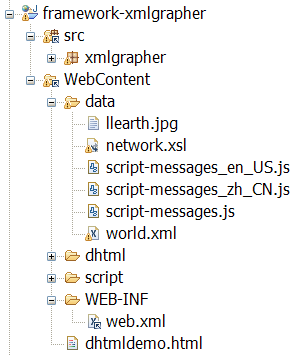Before implementing the globalization mechanism, you should first
create a normal JViews JavaScript™
and
Servlet
application.
You can reference the section Creating
a JavaScript Web application to learn how to integrate a JViews
JavaScript library into your application. Then you can follow the
steps in the next sections to localize your application.
Determine the active locale
JViews JavaScript applications use an active locale when
searching for localized resources. The active locale is
determined by a Servlet class, which is configured in
web.xml
:
<web-app>
...
<servlet>
<servlet-name>
XmlGrapherServlet
</servlet-name>
<servlet-class>
xmlgrapher.servlet.XmlGrapherServlet
</servlet-class>
<servlet-mapping>
<servlet-name>
XmlGrapherServlet
</servlet-name>
<url-pattern>
/xmlgrapher.servlet.XmlGrapherServlet
</url-pattern>
</servlet-mapping>
...
</web-app>
As a convenience, the JViews library
already provides predefined Servlet classes for each product to
take care of both image generation and locale determination. You
only need to inherit from the corresponding Servlet class for
your application.
In the preceding example, the
XmlGrapherServlet
extends
ilog.views.servlet.IlvManagerServlet
:
public class XmlGrapherServlet extends IlvManagerServlet {...}
You can find the predefined JViews Servlet classes in the
section Servlet classes.
In the case where you want to create your own Servlet class for
locale determination, the JViews library also provides the
support class IlvScriptMessageServletSupport. This class
gets the current locale in thread context and return
locale-specific JavaScript message files to the client. The
following code fragment shows how to use this class:
private IlvScriptMessageServletSupport _scriptMessageServletSupport=null;
public boolean handleRequest(HttpServletRequest request, HttpServletResponse response) throws IOException, ServletException {
String type = request.getParameter("request");
if (IlvScriptMessageServletSupport.REQUEST_TYPE.equals(type)) {
doGetScriptMessage(request, response);
return true;
}
...
}
private void doGetScriptMessage(HttpServletRequest request, HttpServletResponse response)throws IOException, ServletException {
if (_scriptMessageServletSupport==null) getScriptMessageSupport();
_scriptMessageServletSupport.handleRequest(request, response);
}
public IlvScriptMessageServletSupport getScriptMessageSupport() {
if (_scriptMessageServletSupport==null)
_scriptMessageServletSupport = new IlvScriptMessageServletSupport(this.getContext());
return _scriptMessageServletSupport;
}
Create locale-specific JavaScript message data
In a JViews JavaScript application,
locale-specific data is supplied separately according to the
user's language and region. However, it is backed up by a set of
JavaScript files for different locales.
To create locale-specific message data:
- Create the default JavaScript message bundle file
script-messages.jsand put it in theWebContent/datadirectory in the Eclipse™ dynamic web project. Thisscript-messages.jsfile is used as the default file if no locale is matched with the requested locales. - Add the locale-specific JavaScript message bundle files under the same directory as the default one. For example, add
script-messages_en_US.jsandscript-messages_zh_CN.jsin the same folder asscript-messages.js. The project hierarchy is shown in the following figure:
- Organize the JavaScript message properties as a JavaScript class in curly brackets.For example, in the
script-messages.jsfile:jviews.messages.demo={}; jviews.messages.demo.xmlgrapher={}; jviews.messages.demo.xmlgrapher.script = { panMapToNorth:"pan the map to the north", ... Resizefor800x600Monitor:"Resize for 800x600 monitor" };If the message value is represented by Unicode characters (for example, the Chinese characters inscript-messages_zh_CN.js), you also need to manually convert the content of the file into Unicode escape format.
Retrieve locale-specific data
As in JViews JavaServer™ Faces (JSF)
applications, there are two places where localized data is
required:
- client side: translated labels, button text, JavaScript messages, and other displayed items.
- server side: displaying error or information messages.
The mechanism to retrieve locale-specific data on the server side
is the same as for JViews JSF applications. See Retrieve locale-specific data for more
details.
To retrieve locale-specific JavaScript
message files in web pages:
- Retrieve the locale-specific JavaScript message property value in the HTML page.To do this:
- Add UTF-8 support in HTML page by adding the following code to the header section of the JavaServer™ Pages (JSP) page:
<meta http-equiv="Content-Type" content="text/html; charset=UTF-8" /> - Specify the locale determination Servlet class by using the JavaScript API
IlvMessages.setLocaleDeterminationServlet(ServletUrl). For example, specify the Servlet class defined inweb.xml:<script TYPE="text/javascript"> var localeServletUrl='/framework-xmlgrapher/xmlgrapher.servlet.XmlGrapherServlet'; IlvMessages.setLocaleDeterminationServlet(localeServletUrl); ... </script> - Then you can determine which locale-specific JavaScript message file should be loaded.
- Specify the JavaScript message file URL for loading by using JavaScript API
IlvMessages.loadLocalizedMessages(ScriptUrl).The code fragment should now look like:<script TYPE="text/javascript"> var localeServletUrl='/framework-xmlgrapher/xmlgrapher.servlet.XmlGrapherServlet'; IlvMessages.setLocaleDeterminationServlet(localeServletUrl); IlvMessages.loadLocalizedMessages("/data/script-messges.js"); ... </script>In the web page, use the complete JavaScript class path, such asChildClassName.key, to retrieve the corresponding value from the JavaScript message file.For example, to set the translated message to be displayed when the mouse is over the button, code as follows:var topbutton = new IlvButton(); topbutton.setMessage(jviews.messages.demo.xmlgrapher.script.panMapToNorth)The page hierarchy should now look like:<html> <head> <META HTTP-EQUIV="Expires" CONTENT="Mon, 01 Jan 1990 00:00:01 GMT"> <META HTTP-EQUIV="Pragma" CONTENT="no-cache"> <meta http-equiv="Content-Type" content="text/html; charset=UTF-8" /> </head> <script TYPE="text/javascript" src="script/IlvUtil.js" ></script> <script TYPE="text/javascript"> var localeServletUrl='/framework-xmlgrapher/xmlgrapher.servlet.XmlGrapherServlet'; IlvMessages.setLocaleDeterminationServlet(localeServletUrl); IlvMessages.loadLocalizedMessages("/data/script-messges.js"); ... </script> //other necessary JavaScript files ... <body> ... var topbutton = new IlvButton(); topbutton.setMessage(jviews.messages.demo.xmlgrapher.script.panMapToNorth) ... </body> </html>
Specify the preferred locale in the languages option of the browser
Note that the specified language in the browser should be
supported. If there is no match with a locale-specific message
property files, the default
script-messages.js
is used.
Referenced example
For more detail, see the referenced JavaScript web application
globalization example in <installdir> /jviews-framework810/samples/xmlgrapher/index.html.